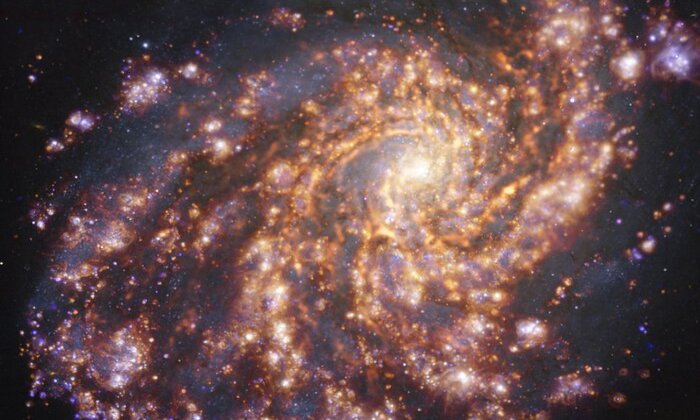Eddie Gonzales Jr. – MessageToEagle.com – Using the European Southern Observatory’s Very Large Telescope (ESO’s VLT) astronomers released new observations of nearby galaxies that resemble colorful cosmic fireworks.
NGC 4254 as seen with the VLT and ALMA at several wavelengths of light. Credit: ESO/ALMA (ESO/NAOJ/NRAO)/PHANGS
The images show different components of the galaxies in distinct colors, allowing astronomers to pinpoint the locations of young stars and the gas they warm up around them.
“For the first time we are resolving individual units of star formation over a wide range of locations and environments in a sample that well represents the different types of galaxies,” says Eric Emsellem, an astronomer at ESO in Germany and lead of the VLT-based observations conducted as part of the Physics at High Angular resolution in Nearby GalaxieS (PHANGS) project.
“We can directly observe the gas that gives birth to stars, we see the young stars themselves, and we witness their evolution through various phases,” Emsellem said in a press release.
Emsellem, who is also affiliated with the University of Lyon, France, and his team have now released their latest set of galactic scans, taken with the Multi-Unit Spectroscopic Explorer (MUSE) instrument on ESO’s VLT in the Atacama Desert in Chile. They used MUSE to trace newborn stars and the warm gas around them, which is illuminated and heated up by the stars and acts as a smoking gun of ongoing star formation.
The new MUSE images are now being combined with observations of the same galaxies taken with ALMA and released earlier this year. ALMA, which is also located in Chile, is especially well suited to mapping cold gas clouds — the parts of galaxies that provide the raw material out of which stars form.
By combining MUSE and ALMA images astronomers can examine the galactic regions where star formation is happening, compared to where it is expected to happen, so as to better understand what triggers, boosts or holds back the birth of new stars. The resulting images are stunning, offering a spectacularly colorful insight into stellar nurseries in our neighboring galaxies.
“There are many mysteries we want to unravel,” says Kathryn Kreckel from the University of Heidelberg in Germany and PHANGS team member.
NGC 3627 as seen with the VLT and ALMA at several wavelengths of light. Image credit: ESO/ALMA (ESO/NAOJ/NRAO)/PHANGS
“Are stars more often born in specific regions of their host galaxies — and, if so, why? And after stars are born how does their evolution influence the formation of new generations of stars?”
Astronomers will now be able to answer these questions thanks to the wealth of MUSE and ALMA data the PHANGS team have obtained.
“Their combination allows us to probe the various stages of stellar birth — from the formation of the stellar nurseries to the onset of star formation itself and the final destruction of the nurseries by the newly born stars — in more detail than is possible with individual observations,” says PHANGS team member Francesco Belfiore from INAF-Arcetri in Florence, Italy.
“PHANGS is the first time we have been able to assemble such a complete view, taking images sharp enough to see the individual clouds, stars, and nebulae that signify forming stars.”
The work carried out by the PHANGS project will be further honed by upcoming telescopes and instruments, such as NASA’s James Webb Space Telescope. The data obtained in this way will lay further groundwork for observations with ESO’s future Extremely Large Telescope (ELT), which will start operating later this decade and will enable an even more detailed look at the structures of stellar nurseries.
“As amazing as PHANGS is, the resolution of the maps that we produce is just sufficient to identify and separate individual star-forming clouds, but not good enough to see what’s happening inside them in detail,” pointed out Eva Schinnerer, a research group leader at the Max Planck Institute for Astronomy in Germany and principal investigator of the PHANGS project, under which the new observations were conducted.
“New observational efforts by our team and others are pushing the boundary in this direction, so we have decades of exciting discoveries ahead of us.”
Written by Eddie Gonzales Jr. MessageToEagle.com Staff








